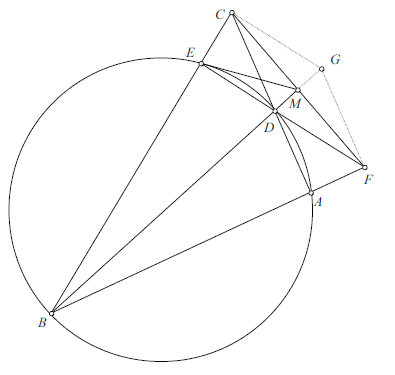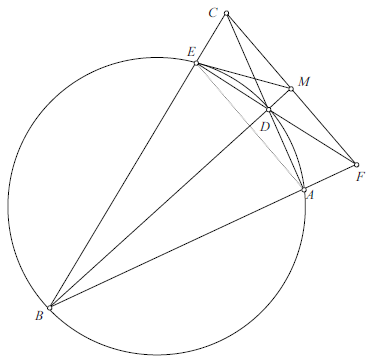Difference between revisions of "2003 USAMO Problems/Problem 4"
(→Solution 2) |
5849206328x (talk | contribs) (official solutions (rather, cleaning up solutions already present on page)) |
||
| Line 3: | Line 3: | ||
Let <math>ABC</math> be a triangle. A circle passing through <math>A</math> and <math>B</math> intersects segments <math>AC</math> and <math>BC</math> at <math>D</math> and <math>E</math>, respectively. Lines <math>AB</math> and <math>DE</math> intersect at <math>F</math>, while lines <math>BD</math> and <math>CF</math> intersect at <math>M</math>. Prove that <math>MF = MC</math> if and only if <math>MB\cdot MD = MC^2</math>. | Let <math>ABC</math> be a triangle. A circle passing through <math>A</math> and <math>B</math> intersects segments <math>AC</math> and <math>BC</math> at <math>D</math> and <math>E</math>, respectively. Lines <math>AB</math> and <math>DE</math> intersect at <math>F</math>, while lines <math>BD</math> and <math>CF</math> intersect at <math>M</math>. Prove that <math>MF = MC</math> if and only if <math>MB\cdot MD = MC^2</math>. | ||
| − | == Solution == | + | == Solutions == |
| − | + | === Solution 1 === | |
| − | + | Extend segment <math>DM</math> through <math>M</math> to <math>G</math> such that <math>FG\parallel CD</math>. | |
| − | < | + | <center>[[File:2003usamo4-1.png]]</center> |
| − | |||
| − | |||
| − | |||
| − | |||
| − | + | Then <math>MF = MC</math> if and only if quadrilateral <math>CDFG</math> is a parallelogram, or, <math>FD\parallel CG</math>. Hence <math>MC = MF</math> if and only if <math>\angle GCD = \angle FDA</math>, that is, <math>\angle FDA + \angle CGF = 180^\circ</math>. | |
| − | < | + | Because quadrilateral <math>ABED</math> is cyclic, <math>\angle FDA = \angle ABE</math>. It follows that <math>MC = MF</math> if and only if |
| − | + | <cmath>180^\circ = \angle FDA + \angle CGF = \angle ABE + \angle CGF,</cmath> | |
| − | + | that is, quadrilateral <math>CBFG</math> is cyclic, which is equivalent to | |
| − | + | <cmath>\angle CBM = \angle CBG = \angle CFG = \angle DCF = \angle DCM.</cmath> | |
| − | + | Because <math>\angle DMC = \angle CMB</math>, <math>\angle CBM = \angle DCM</math> if and only if triangles <math>BCM</math> and <math>CDM</math> are similar, that is | |
| − | + | <cmath>\frac{CM}{BM} = \frac{DM}{CM},</cmath> | |
| − | + | or <math>MB\cdot MD = MC^2</math>. | |
| − | |||
| − | |||
| − | |||
| − | |||
| − | |||
| − | |||
| − | |||
| − | |||
| − | |||
| − | |||
| − | |||
| − | |||
| − | |||
| − | |||
| − | |||
| − | |||
| − | |||
| − | |||
| − | |||
| − | |||
| − | |||
| − | |||
| − | </ | ||
| − | ==Solution 2== | + | === Solution 2 === |
| − | + | We first assume that <math>MB\cdot MD = MC^2</math>. Because <math>\frac{MC}{MD} = \frac{MB}{MC}</math> and <math>\angle CMD = \angle BMC</math>, triangles <math>CMD</math> and <math>BMC</math> are similar. Consequently, <math>\angle MCD = \angle MBC</math>. | |
| − | + | <center>[[File:2003usamo4-2.png]]</center> | |
| − | + | Because quadrilateral <math>ABED</math> is cyclic, <math>\angle DAE = \angle DBE</math>. Hence | |
| + | <cmath>\angle FCA = \angle MCD = \angle MBC = \angle DBE = \angle DAE = \angle CAE,</cmath> | ||
| + | implying that <math>AE\parallel CF</math>, so <math>\angle AEF = \angle CFE</math>. Because quadrilateral <math>ABED</math> is cyclic, <math>\angle ABD = \angle AED</math>. Hence | ||
| + | <cmath>\angle FBM = \angle ABD = \angle AED = \angle AEF = \angle CFE = \angle MFD.</cmath> | ||
| + | Because <math>\angle FBM = \angle DFM</math> and <math>\angle FMB = \angle DMF</math>, triangles <math>BFM</math> and <math>FDM</math> are similar. Consequently, <math>\frac{FM}{DM} = \frac{BM}{FM}</math>, or <math>FM^2 = BM\cdot DM = CM^2</math>. Therefore <math>MC^2 = MB\cdot MD</math> implies <math>MC = MF</math>. | ||
| − | + | Now we assume that <math>MC = MF</math>. Applying Ceva's Theorem to triangle <math>BCF</math> and cevians <math>BM, CA, FE</math> gives | |
| + | <cmath>\frac{BA}{AF}\cdot\frac{FM}{MC}\cdot\frac{CE}{EB} = 1,</cmath> | ||
| + | implying that <math>\frac{BA}{AF} = \frac{BE}{EC}</math>, so <math>AE\parallel CF</math>. | ||
| + | |||
| + | Consequently, <math>\angle DCM = \angle DAE</math>. Because quadrilateral <math>ABED</math> is cyclic, <math>\angle DAE = \angle DBE</math>. Hence | ||
| + | <cmath>\angle DCM = \angle DAE = \angle DBE = \angle CBM.</cmath> | ||
| + | Because <math>\angle CBM = \angle DCM</math> and <math>\angle CMB = \angle DMC</math>, triangles <math>BCM</math> and <math>CDM</math> are similar. Consequently, <math>\frac{CM}{DM} = \frac{BM}{CM}</math>, or <math>CM^2 = BM\cdot DM</math>. | ||
| + | |||
| + | Combining the above, we conclude that <math>MF = MC</math> if and only if <math>MB\cdot MD = MC^2</math>. | ||
| + | |||
| + | {{alternate solutions}} | ||
== See also == | == See also == | ||
Revision as of 11:28, 17 July 2014
Problem
Let ![]() be a triangle. A circle passing through
be a triangle. A circle passing through ![]() and
and ![]() intersects segments
intersects segments ![]() and
and ![]() at
at ![]() and
and ![]() , respectively. Lines
, respectively. Lines ![]() and
and ![]() intersect at
intersect at ![]() , while lines
, while lines ![]() and
and ![]() intersect at
intersect at ![]() . Prove that
. Prove that ![]() if and only if
if and only if ![]() .
.
Solutions
Solution 1
Extend segment ![]() through
through ![]() to
to ![]() such that
such that ![]() .
.

Then ![]() if and only if quadrilateral
if and only if quadrilateral ![]() is a parallelogram, or,
is a parallelogram, or, ![]() . Hence
. Hence ![]() if and only if
if and only if ![]() , that is,
, that is, ![]() .
.
Because quadrilateral ![]() is cyclic,
is cyclic, ![]() . It follows that
. It follows that ![]() if and only if
if and only if
![]() that is, quadrilateral
that is, quadrilateral ![]() is cyclic, which is equivalent to
is cyclic, which is equivalent to
![]() Because
Because ![]() ,
, ![]() if and only if triangles
if and only if triangles ![]() and
and ![]() are similar, that is
are similar, that is
![]() or
or ![]() .
.
Solution 2
We first assume that ![]() . Because
. Because ![]() and
and ![]() , triangles
, triangles ![]() and
and ![]() are similar. Consequently,
are similar. Consequently, ![]() .
.

Because quadrilateral ![]() is cyclic,
is cyclic, ![]() . Hence
. Hence
![]() implying that
implying that ![]() , so
, so ![]() . Because quadrilateral
. Because quadrilateral ![]() is cyclic,
is cyclic, ![]() . Hence
. Hence
![]() Because
Because ![]() and
and ![]() , triangles
, triangles ![]() and
and ![]() are similar. Consequently,
are similar. Consequently, ![]() , or
, or ![]() . Therefore
. Therefore ![]() implies
implies ![]() .
.
Now we assume that ![]() . Applying Ceva's Theorem to triangle
. Applying Ceva's Theorem to triangle ![]() and cevians
and cevians ![]() gives
gives
![]() implying that
implying that ![]() , so
, so ![]() .
.
Consequently, ![]() . Because quadrilateral
. Because quadrilateral ![]() is cyclic,
is cyclic, ![]() . Hence
. Hence
![]() Because
Because ![]() and
and ![]() , triangles
, triangles ![]() and
and ![]() are similar. Consequently,
are similar. Consequently, ![]() , or
, or ![]() .
.
Combining the above, we conclude that ![]() if and only if
if and only if ![]() .
.
Alternate solutions are always welcome. If you have a different, elegant solution to this problem, please add it to this page.
See also
| 2003 USAMO (Problems • Resources) | ||
| Preceded by Problem 3 |
Followed by Problem 5 | |
| 1 • 2 • 3 • 4 • 5 • 6 | ||
| All USAMO Problems and Solutions | ||
The problems on this page are copyrighted by the Mathematical Association of America's American Mathematics Competitions. 









